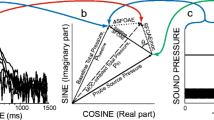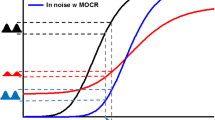ABSTRACT
Auditory enhancement refers to the perceptual phenomenon that a target sound is heard out more readily from a background sound if the background is presented alone first. Here we used stimulus-frequency otoacoustic emissions (SFOAEs) to test the hypothesis that activation of the medial olivocochlear efferent system contributes to auditory enhancement effects. The SFOAEs were used as a tool to measure changes in cochlear responses to a target component and the neighboring components of a multitone background between conditions producing enhancement and conditions producing no enhancement. In the “enhancement” condition, the target and multitone background were preceded by a precursor stimulus with a spectral notch around the signal frequency; in the control (no-enhancement) condition, the target and multitone background were presented without the precursor. In an experiment using a wideband multitone stimulus known to produce significant psychophysical enhancement effects, SFOAEs showed no changes consistent with enhancement, but some aspects of the results indicated possible contamination of the SFOAE magnitudes by the activation of the middle-ear-muscle reflex. The same SFOAE measurements performed using narrower-band stimuli at lower sound levels also showed no SFOAE changes consistent with either absolute or relative enhancement despite robust psychophysical enhancement effects observed in the same listeners with the same stimuli. The results suggest that cochlear efferent control does not play a significant role in auditory enhancement effects.










Similar content being viewed by others
REFERENCES
Abdala C, Mishra SK, Williams TL (2009) Considering distortion product otoacoustic emission fine structure in measurements of the medial olivocochlear reflex. J Acoust Soc Am 125:1584–1594
Backus BC, Guinan JJ Jr (2006) Time-course of the human medial olivocochlear reflex. J Acoust Soc Am 119:2889–2904
Boyev KP, Liberman MC, Brown MC (2002) Effects of anesthesia on efferent-mediated adaptation of the DPOAE. J Assoc Res Otolaryngol 3:362–373
Brass D, Kemp DT (1993) Suppression of stimulus frequency otoacoustic emissions. J Acoust Soc Am 93:920–939
Byrne AJ, Stellmack MA, Viemeister NF (2011) The enhancement effect: evidence for adaptation of inhibition using a binaural centering task. J Acoust Soc Am 129:2088–2094
Byrne AJ, Stellmack MA, Viemeister NF (2013) The salience of enhanced components within inharmonic complexes. J Acoust Soc Am 134:2631–2634
Carcagno S, Semal C, Demany L (2012) Auditory enhancement of increments in spectral amplitude stems from more than one source. J Assoc Res Otolaryngol 13:693–702
Carcagno S, Semal C, Demany L (2013) No need for templates in the auditory enhancement effect. PLoS One 8:e67874
Carcagno S, Plack CJ, Portron A, Semal C, Demany L (2014) The auditory enhancement effect is not reflected in the 80-Hz auditory steady-state response. J Assoc Res Otolaryngol 15:621–630
Chambers AR, Hancock KE, Maison SF, Liberman MC, Polley DB (2012) Sound-evoked olivocochlear activation in unanesthetized mice. J Assoc Res Otolaryngol 13:209–217
Champlin CA, McFadden D (1989a) Effects of intense sound exposures and aspirin on overshoot. J Acoust Soc Am 85:s36
Champlin CA, McFadden D (1989b) Reductions in overshoot following intense sound exposures. J Acoust Soc Am 85:2005–2011
Demany L, Carcagno S, Semal C (2013) The perceptual enhancement of tones by frequency shifts. Hear Res 298:10–16
Dolan DF, Nuttall AL (1988) Masked cochlear whole-nerve response intensity functions altered by electrical stimulation of the crossed olivocochlear bundle. J Acoust Soc Am 83:1081–1086
Erviti M, Semal C, Demany L (2011) Enhancing a tone by shifting its frequency or intensity. J Acoust Soc Am 129:3837–3845
Ewert SD (2013) AFC: a modular for running psychoacoustic experiments and computational perception models. In: Proceedings of the International Conference on Acoustics AIA-DAGA, Merano, Italy, pp 1326–1329
Eze N, Olson ES (2011) Basilar membrane velocity in a cochlea with a modified organ of Corti. Biophys J 100:858–867
Feeney MP, Keefe DH (2001) Estimating the acoustic reflex threshold from wideband measures of reflectance, admittance, and power. Ear Hear 22:316–332
Feeney MP, Keefe DH, Sanford CA (2004) Wideband reflectance measures of the ipsilateral acoustic stapedius reflex threshold. Ear Hear 25:421–430
Ghaffari R, Aranyosi AJ, Freeman DM (2007) Longitudinally propagating traveling waves of the mammalian tectorial membrane. Proc Natl Acad Sci U S A 104:16510–16515
Goodman SS, Keefe DH (2006) Simultaneous measurement of noise-activated middle-ear muscle reflex and stimulus frequency otoacoustic emissions. J Assoc Res Otolaryngol 7:125–139
Guinan JJ Jr (2006) Olivocochlear efferents: anatomy, physiology, function, and the measurement of efferent effects in humans. Ear Hear 27:589–607
Guinan JJ Jr, Backus BC, Lilaonitkul W, Aharonson V (2003) Medial olivocochlear efferent reflex in humans: otoacoustic emission (OAE) measurement issues and the advantages of stimulus frequency OAEs. J Assoc Res Otolaryngol 4:521–540
Jau YC, Geisler CD (1983) Results from a cochlear model utilizing longitudinal coupling. In: De Boer E, Viergever MA (eds) Mechanics of hearing. Delft University Press, The Netherlands, pp 169–176
Jennings SG, Strickland EA (2012) Evaluating the effects of olivocochlear feedback on psychophysical measures of frequency selectivity. J Acoust Soc Am 132:2483–2496
Kawase T, Delgutte B, Liberman MC (1993) Antimasking effects of the olivocochlear reflex. II. Enhancement of auditory-nerve response to masked tones. J Neurophysiol 70:2533–2549
Kruschke JK (2013) Bayesian estimation supersedes the t test. J Exp Psychol Gen 142:573–603
Legan PK, Lukashkina VA, Goodyear RJ, Kossi M, Russell IJ, Richardson GP (2000) A targeted deletion in alpha-tectorin reveals that the tectorial membrane is required for the gain and timing of cochlear feedback. Neuron 28:273–285
Levitt H (1971) Transformed up–down methods in psychoacoustics. J Acoust Soc Am 49:467–477
Lilaonitkul W, Guinan JJ Jr (2009) Reflex control of the human inner ear: a half-octave offset in medial efferent feedback that is consistent with an efferent role in the control of masking. J Neurophysiol 101:1394–1406
Lilaonitkul W, Guinan JJ Jr (2012) Frequency tuning of medial–olivocochlear–efferent acoustic reflexes in humans as functions of probe frequency. J Neurophysiol 107:1598–1611
Lopez-Poveda EA, Plack CJ, Meddis R (2003) Cochlear nonlinearity between 500 and 8000 Hz in listeners with normal hearing. J Acoust Soc Am 113:951–960
Mammano F, Nobili R (1993) Biophysics of the cochlea: linear approximation. J Acoust Soc Am 93:3320–3332
Meaud J, Grosh K (2010) The effect of tectorial membrane and basilar membrane longitudinal coupling in cochlear mechanics. J Acoust Soc Am 127:1411–1421
Meaud J, Grosh K (2014) Effect of the attachment of the tectorial membrane on cochlear micromechanics and two-tone suppression. Biophys J 106:1398–1405
Møller AG (1965) An experimental study of the acoustic impedance of the middle ear system and its transmission properties. Acta Otolaryngol 60:129–149
Naidu RC, Mountain DC (2001) Longitudinal coupling in the basilar membrane. J Assoc Res Otolaryngol 2:257–267
Naidu RC, Mountain DC (2007) Basilar membrane tension calculations for the gerbil cochlea. J Acoust Soc Am 121:994–1002
Nelson PC, Young ED (2010) Neural correlates of context-dependent perceptual enhancement in the inferior colliculus. J Neurosci 30:6577–6587
Nelson DA, Schroder AC, Wojtczak M (2001) A new procedure for measuring peripheral compression in normal-hearing and hearing-impaired listeners. J Acoust Soc Am 110:2045–2064
Oxenham AJ, Plack CJ (1997) A behavioral measure of basilar-membrane nonlinearity in listeners with normal and impaired hearing. J Acoust Soc Am 101:3666–3675
Palmer AR, Summerfield Q, Fantini DA (1995) Responses of auditory-nerve fibers to stimuli producing psychophysical enhancement. J Acoust Soc Am 97:1786–1799
Ruggero MA (1992) Responses to sound of the basilar membrane of the mammalian cochlea. Curr Opin Neurobiol 2:449–456
Russell IJ, Legan PK, Lukashkina VA, Lukashkin AN, Goodyear RJ, Richardson GP (2007) Sharpened cochlear tuning in a mouse with a genetically modified tectorial membrane. Nat Neurosci 10:215–223
Sachs MB, Kiang NYS (1968) Two-tone inhibition in auditory nerve fibers. J Acoust Soc Am 43:1120–1128
Schairer KS, Ellison JC, Fitzpatrick D, Keefe DH (2007) Wideband ipsilateral measurements of middle-ear muscle reflex thresholds in children and adults. J Acoust Soc Am 121:3607–3616
Shera CA, Cooper NP (2013) Basilar-membrane interference patterns from multiple internal reflection of cochlear traveling waves. J Acoust Soc Am 133:2224–2239
Shera CA, Guinan JJ Jr (1999) Evoked otoacoustic emissions arise by two fundamentally different mechanisms: a taxonomy for mammalian OAEs. J Acoust Soc Am 105:782–798
Shera CA, Guinan JJ (2003) Stimulus-frequency-emission group delay: a test of coherent reflection filtering and a window on cochlear tuning. J Acoust Soc Am 113:2762–2772
Smith RL (1977) Short-term adaptation in single auditory nerve fibers: some poststimulatory effects. J Neurophysiol 40:1098–1112
Strickland EA (2001) The relationship between frequency selectivity and overshoot. J Acoust Soc Am 109:2062–2073
Strickland EA (2004) The temporal effect with notched-noise maskers: analysis in terms of input–output functions. J Acoust Soc Am 115:2234–2245
Strickland EA, Krishnan LA (2005) The temporal effect in listeners with mild to moderate cochlear hearing impairment. J Acoust Soc Am 118:3211–3217
Summerfield AQ, Assmann P (1987) Auditory enhancement in speech perception. In: Schouten MEH (ed) The psychophysics of speech perception. Martinus Nijhoff, Dordrecht, pp 140–150
Summerfield Q, Haggard MP, Foster J, Gray S (1984) Perceiving vowels from uniform spectra: phonetic exploration of an auditory after-effect. Percept Psychophys 35:203–213
Summerfield AQ, Sidwell AS, Nelson T (1987) Auditory enhancement of changes in spectral amplitude. J Acoust Soc Am 81:700–708
Thibodeau LM (1991) Performance of hearing-impaired persons on auditory enhancement tasks. J Acoust Soc Am 89:2843–2850
Thibodeau LM (1996) Evaluation of auditory enhancement and auditory suppression in listeners with normal hearing and reduced speech recognition in noise. J Speech Hear Res 39:947–956
Viemeister NF (1980) Adaptation of masking. In: Psychophysical, physiological, and behavioural studies in hearing. In: van den Brink G, Bilsen FA (eds) Delft, U. P., Delft, Netherlands, pp 190–198
Viemeister NF, Bacon SP (1982) Forward masking by enhanced components in harmonic complexes. J Acoust Soc Am 71:1502–1507
von Klitzing R, Kohlrausch A (1994) Effect of masker level on overshoot in running- and frozen-noise maskers. J Acoust Soc Am 95:2192–2201
Walsh KP, Pasanen EG, McFadden D (2010) Overshoot measured physiologically and psychophysically in the same human ears. Hear Res 268:22–37
Wang N, Kreft H, Oxenham AJ (2012) Vowel enhancement effects in cochlear-implant users. J Acoust Soc Am 131:EL421–EL426
Westerman LA, Smith RL (1984) Rapid and short-term adaptation in auditory nerve responses. Hear Res 15:249–260
Winslow RL, Sachs MB (1988) Single-tone intensity discrimination based on auditory-nerve responses in backgrounds of quiet, noise, and with stimulation of the crossed olivocochlear bundle. Hear Res 35:165–190
Wojtczak M, Beim JA, Oxenham AJ (2015) Exploring the role of feedback-based auditory reflexes in forward masking by schroeder-phase complexes. J Assoc Res Otolaryngol 16:81–99
Yates GK (1990) Basilar membrane nonlinearity and its influence on auditory nerve rate-intensity functions. Hear Res 50:145–162
ACKNOWLEDGMENTS
This study was supported by grant R01 DC 010374 from the National Institutes of Health, awarded to author MW. The authors thank two anonymous reviewers for their helpful comments on the previous version of the manuscript.
Author information
Authors and Affiliations
Corresponding author
Rights and permissions
About this article
Cite this article
Beim, J.A., Elliott, M., Oxenham, A.J. et al. Stimulus Frequency Otoacoustic Emissions Provide No Evidence for the Role of Efferents in the Enhancement Effect. JARO 16, 613–629 (2015). https://doi.org/10.1007/s10162-015-0534-8
Received:
Accepted:
Published:
Issue Date:
DOI: https://doi.org/10.1007/s10162-015-0534-8




